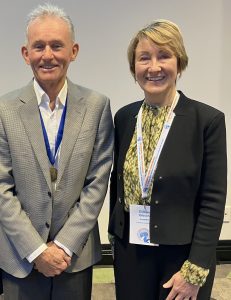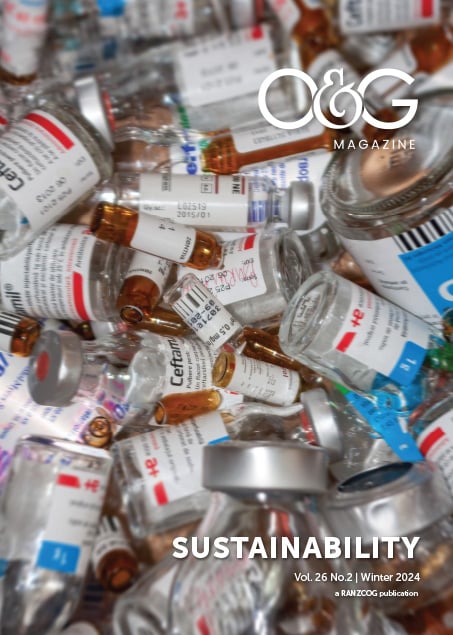Making a difference: We in the PSRH can do it
This is an edited version of the Brian Spurrett Oration delivered at the Pacific Society for Reproductive Health 15th Biennial Conference held in Auckland, Aotearoa New Zealand from 18 – 22 March 2024 by Emeritus Professor Peter Stone, with the support of Brian’s family and the Pacific Society for Reproductive Health (PSRH).

Emeritus Professor Peter Stone and RANZCOG President Gillian Gibson
at the 2024 PSRH Conference. Photo: Carolyn Poljski
As a long-standing member of PSRH myself, it was a great honour to have been asked to deliver this year’s Brian Spurrett Oration. As well as acknowledging the Maori of the land here, and my own maunga (Mangere, where I grew up), I want to especially acknowledge all those today who have had adverse pregnancy or perinatal outcomes, as well as those who have been victims of domestic violence.
I want to start with a story. In 1975, I excitedly went to Apia, Samoa for my sixth-year elective. It was a chance to learn paediatrics as well as have a good time in the Pacific. But I was shocked, not by the potholed road from the airport to the old, dilapidated hospital, but what I saw in that hospital. I could not believe it. I saw children with diseases of malnutrition including kwashiorkor and marasmus. How could this be? What was happening? There was fruit on the trees, taro growing everywhere, the Saturday market was full of produce. Why were these infants being brought into the hospital with these diseases?
Some were sick from infections, or from the use of formula (due to problems preparing and storing powdered milk, especially after it has been made up) instead of breast milk because it was believed to be better. Some had parents caught up in personal family and financial struggles. Some children survived, some did not. As a young impressionable trainee intern not used to death, this was truly shocking. I asked myself what will happen to the survivors. How will these children grow up? What are the consequences of this? Let’s have a look first at global infant mortality.
New Zealand too has a problem with infant mortality. New Zealand ranks the ninth highest in the OECD nations1. Who are the children who are dying? As New Zealand’s national mortality data collection shows, all-cause mortality in 0–14-year-olds (excluding neonates) from 2014–2018 were Maori and Pacific infants aged 0-4 years and those from low-income families1. There are over 300,000 children living in poverty and severely constrained conditions in New Zealand. The vast majority of these children are Maori or from the Pacific region1.
Tackling child poverty
So, how do we address child poverty? My medical school friend and colleague paediatrician Dr Johan Morreau and Dr Felicia Low at the University of Auckland’s Koi Tū – The Centre for Informed Futures have just published a paper, Early investment: A key to reversing intergenerational disadvantage and inequity in Aotearoa New Zealand2, which presents approaches to tackling the issues of poverty and its effects. For the best chance of breaking the cycle of intergenerational disadvantage, New Zealand urgently needs to invest in young people before they become parents, in pregnant women and their families, and in babies and children. The data from the University of Auckland modelling and literature review shows unequivocally that investment in prenatal programs and early years programs yield most return on the investment in human capital.
How can this be done? How do we find out what the woman’s and parents’ needs are? We can adopt a He Korowai Manaaki approach (pregnancy wraparound care) so that our clinics and home visits are places for shelter, care and nurturing.
I was part of a project set up in Wairoa on the east coast of the North Island of New Zealand, a small, isolated town with a proud history but suffering from rural decline. There are 120 births each year in a community that is 80 per cent Maori. We set up a pilot project to deliver high-quality ultrasound in the clinic, where pregnant women also met with midwives. Based on the success of this pilot, we have just completed a randomised controlled trial of two forms of pregnancy care, comparing outcomes of standard care to wraparound care. It appears that vaccination rates, contraceptive use after pregnancy, linkage to social agencies and engagement with general practice after the birth are all improved with wraparound care, demonstrating that parents-to-be engaging with the maternity system as early on in the pregnancy as possible is essential.
It is not only in pregnancy that we can make a difference. We have work to do with intrapartum care as well. We have a neonatal encephalopathy group in New Zealand which analyses and publishes data. This group has shown that there are indeed modifiable factors, which if addressed, would improve the outcome for our children, as has been shown in work by Dr Lynn Sadler and others3.
After birth we also have work to do to make a difference. We need to promote safe sleeping practices, no smoking around babies, and the use of the wahakura (pepi-pod) so that we can reduce sudden unexpected death in infancy (SUDI) in culturally appropriate ways. It is sad to note that, according to the New Zealand Ministry of Health, the number of infants who die from sudden unexpected death is not declining and that the rate of SUDI is higher for babies who are Māori or who live in areas of high deprivation4.
Maternal mortality and gender-based violence
We have talked a lot about our offspring. But what about women? Maternal mortality remains high in the Pacific. In New Zealand, the maternal mortality ratio (MMR) is nearly twice that of Australia or Sweden. And in Pacific nations that do report to UNFPA, such as Papua New Guinea, Solomon Islands and Kiribati, the MMRs are well above the very conservative Sustainable Development Goal of a MMR of 70 per 100,000 live births5.
And maternal death is not the only issue. We cannot hide from gender-based violence. The horrifying figures from the recent Women’s Refuge Annual Report in New Zealand6 should make for very uncomfortable reading. There were 50,000 referrals to Women’s Refuge last year in New Zealand. Of these, 20,000 women were pregnant. Forty percent of women were assaulted during pregnancy and 14% had been coerced into changing their pregnancy plan. Figures from the Pacific suggest even higher rates of violence against women in some countries.
How else can we make a difference? What are our obligations to people in our region? For starters, we can all try to practice the three Cs:
- Care: delivery of quality care
- Compassion: always showing compassion and kindness
- Creativity: thinking outside the square to find solutions to problems
How can we better support women? In the words of Professor Caroline Homer: “Midwives are at the forefront of providing social and emotional support that women having a baby can get access to essential services.” In addition to midwives, we need to ensure women have access to social and support workers.
We can make a difference as professionals, including following accepted guidelines from organisations such as WHO and UNFPA. They provide use with a good structure from which to base our practice. We also need to audit our outcomes. We need to know how we are doing and where we can make improvements and be transparent with our patients. We need to keep data so we can observe change over time. And we need to keep up to date, including attending PSRH Biennial Meetings and other educational activities.
What can PSRH do specifically? PSRH can play a role in education, mentoring and making political submissions. We need to be political, lobbying members of Parliament or funders.
So, friends, if you remember nothing else from this oration, please remember that you can make a difference starting with the three Cs.
Emeritus Professor Peter Stone, MBChB, DipObs, MD (Bristol), FRCOG, FRANZCOG, School of Medicine, University of Auckland and Honorary Professor, National Hospital for Maternal and Child Health, Mongolia, delivered the Brian Spurrett Oration with support from the RANZCOG Women’s Health Foundation.
References
- Duncanson M, Roy M, van Asten H et al. Child Poverty Monitor 2022 Technical Report. New Zealand Child and Youth Epidemiology Service, University of Otago; 2022. Accessed March 2024. www.nzchildren.co.nz
- Morreau J, Low F. Early investment: A key to reversing intergenerational disadvantage and inequity in Aotearoa New Zealand. Koi Tū – The Centre for Informed Futures. 2023. Evidence Brief.
- Sadler LC, Masson VL, Belgrave S et al. Contributory factors and potentially avoidable neonatal encephalopathy associated with acute peripartum events: An observational study. ANZJOG. 2019; 59(5): 699-705. Doi/10.1111/ajo.12957
- Ministry of Health releases three reports on Sudden Unexpected Death in Infancy. New Zealand Ministry of Health; 2022. Accessed February 2024. www.health.govt.nz/news-media/news-items/ministry-health-releases-three-reports-sudden-unexpected-death-infancy
- United Nations Maternal Mortality Estimation Inter-Agency Group. Trends in Maternal Mortality 2000-2020. WHO, UNICEF, UNFPA, World Bank Group and UNDESA/Population Division; 2023. Accessed February 2024. www.unfpa.org/publications/trends-maternal-mortality-2000-2020
- National Collective of Independent Women’s Refuges Research Unit. Safer How, Safer When. Women’s Refuge: 2024. Accessed March 2024. womensrefuge.org.nz/safer-how-safer-when





Leave a Reply